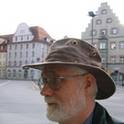
Nazi obsession with art can be understood as a strategy for managing death-anxiety. The venerable trope of "immortal art" took on fetishistic qualities in the fantasies of the Nazi leadership. For many of them, art compensated for the trauma of World War I by framing idealized vitality invested with visionary self-expansiveness, as in the hyperbolic nudes of Thorak and Brekker, combined with a nostalgic recuperation of lost Victorian-era authority. In Ernest Becker’s terms, as creaturely motives, the manic looting of art works described in Lynn Nicholas’ The Rape of Europa acts out greed for life, appropriating hypostatized vitality as the vampire does blood. The compensatory nature of the behavior is crystallized in the famous photos of the doomed Hitler in his bunker gazing down like a god upon his architectural model of Linz, his fantasy shrine of immortal world art and a site for his future tomb. In this fantastic city he is contemplating a world that contains his own death. The eschatological landscape is a tool or a vehicle for thinking about his death; it tames terror with the consoling illusion of posthumous glory and mourning. Viewed this way, the ideal city of art is generically a form of triumphal arch or, more exactly, a mausoleum. In the bunker the model is a stage prop for role-playing at apotheosis. In this theatrical landscape the entranced Hitler plays all the roles: designer, critic, inhabitant, awestruck audience, and conqueror. The model, that is, embodies fantasies of triumphal apotheosis but also of mourning. At once Hitler is the transcendent witness yet also entombed like a sacrificial Wagnerian Siegfried, the martyred hero, an object of admiration and sympathetic forgiveness. Though he consistently favored grandiose public projects, over time the pressure of death awareness reinforced the theme of mourning, most vividly in his obsession with the lost glories of the ancient Greece and Rome. With Speer he designed monuments to look sublime after they had fallen to ruin. The visionary expansiveness masks the underlying suicidal ideation. Like architectural models of his projected Berlin, the model of Linz is an exercise in cognitive denial. It frames and in practice dissociates a dream landscape. As it aggregates conventions and historical forms of authority, it paradoxically abstracts and dehumanizes them, excluding the happenstance sloppiness of a habitat evolved over centuries and actually lived-in. In this way the ideation latent in the model parallels Hitler’s war aims: a drive to obliterate complex, resistant reality in order to replace it with the planner’s expanded, idealized self. The eschatological landscape, then, tacitly embodies the Nazis’ well-known eugenics fantasies. It is a landscape without need for sanitation, nursing homes, or shameful extermination camps. The models present “pure” geometry and hypothetical spaces free of anomaly and circumstantial resistance to imagination – or will. In architecture the self, which in life is not a thing but an event that needs ongoing social substantiation, can be concretized. Embodying the architect, at whatever remove, the model landscape makes him something. It forestalls oblivion. Psychologically, the flimsy object of contemplation in the depths of the doomed bunker is a perverse but not unrelated echo of Augustine’s city of God.
Available at: http://works.bepress.com/kirby_farrell1/15/
